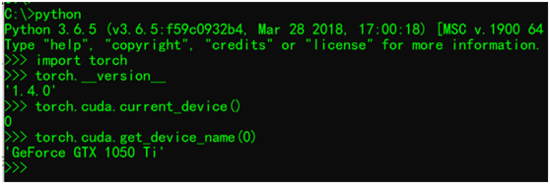您好,登錄后才能下訂單哦!
您好,登錄后才能下訂單哦!
小編這次要用代碼詳解Pytorch的環境搭建與基本語法,文章內容豐富,感興趣的小伙伴可以來了解一下,希望大家閱讀完這篇文章之后能夠有所收獲。
基本思路選擇
以前我用過Caffe,用過tensorflow,最近一直在用pytorch感覺特別好用。所以打算寫點我學習的過程跟經驗,如果你是一個pytorch的高手自然可以忽略,如果你也打算學習pytorch框架,那就跟我一起學習吧,所謂獨學而無友,孤陋而寡聞!
pytorch安裝
01
演示系統環境
CPU版本
install pytorch torchvision cpuonly -c pytorch
GPU版本
install pytorch torchvision cudatoolkit=10.0 -c pytorch
測試安裝是否正常, CUDA支持正常

測試結果一切正常!
安裝的時候你還可以更直接點
pip install pytorch torchvision
就好啦!我知道很多人喜歡用各種python的工具跟IDE做開發,那些都是個人愛好,喜歡就好,但是千萬別強迫別人跟你一樣!有IDE強迫癥!我從開始學習python就一直用pycharm!千萬別問我好用不好用,方便不方便!覺得適合自己即可。
Pytorch基本語法演示
02
演示了pytorch中基本常量、變量、矩陣操作、CUDA調用,numpy與tensor轉化,維度轉化,自動梯度等基本知識。代碼如下:
from __future__ import print_function
import torch
import numpy as np
print(torch.__version__)
# 定義矩陣
x = torch.empty(2, 2)
print(x)
# 定義隨機初始化矩陣
x = torch.randn(2, 2)
print(x)
# 定義初始化為零
x = torch.zeros(3, 3)
print(x)
# 定義數據為tensor
x = torch.tensor([5.1, 2., 3., 1.])
print(x)
# 操作
a = torch.tensor([1.,2.,3.,4.,5.,6.,7.,8.])
b = torch.tensor([11.,12.,13.,14.,15.,16.,17.,18.])
c = a.add(b)
print(c)
# 維度變換 2x4
a = a.view(-1, 4)
b = b.view(-1, 4)
c = torch.add(a, b)
print(c, a.size(), b.size())
# torch to numpy and visa
na = a.numpy()
nb = b.numpy()
print("\na =",na,"\nb =", nb)
# 操作
d = np.array([21.,22.,23.,24.,25.,26.,27.,28.], dtype=np.float32)
print(d.reshape(2, 4))
d = torch.from_numpy(d.reshape(2, 4))
sum = torch.sub(c, d)
print(sum, "\n sum = ", sum.size())
# using CUDA
if torch.cuda.is_available():
result = d.cuda() + c.cuda()
print("\n result = ", result)
# 自動梯度
x = torch.randn(1, 5, requires_grad=True)
y = torch.randn(5, 3, requires_grad=True)
z = torch.randn(3, 1, requires_grad=True)
print("\nx=",x, "\ny=",y, "\nz=",z)
xy = torch.matmul(x, y)
xyz = torch.matmul(xy, z)
xyz.backward()
print(x.grad, y.grad, z.grad)運行輸出結果:
1.4.0
tensor([[0., 0.],
[0., 0.]])
tensor([[-0.4624, -1.1495],
[ 1.9408, -0.1796]])
tensor([[0., 0., 0.],
[0., 0., 0.],
[0., 0., 0.]])
tensor([5.1000, 2.0000, 3.0000, 1.0000])
tensor([12., 14., 16., 18., 20., 22., 24., 26.])
tensor([[12., 14., 16., 18.],
[20., 22., 24., 26.]]) torch.Size([2, 4]) torch.Size([2, 4])a = [[1. 2. 3. 4.]
[5. 6. 7. 8.]]
b = [[11. 12. 13. 14.]
[15. 16. 17. 18.]]
[[21. 22. 23. 24.]
[25. 26. 27. 28.]]
tensor([[-9., -8., -7., -6.],
[-5., -4., -3., -2.]])
sum = torch.Size([2, 4])result = tensor([[33., 36., 39., 42.],
[45., 48., 51., 54.]], device='cuda:0')x= tensor([[ 0.3029, -0.4030, -0.9148, -0.9237, 0.7549]], requires_grad=True)
y= tensor([[-0.9032, -0.4092, -0.0682],
[ 0.3689, -0.9655, -0.1346],
[ 1.5101, 1.4418, 0.1058],
[ 1.0259, -1.6011, 0.4881],
[-0.3989, 0.9156, -1.6290]], requires_grad=True)
z= tensor([[ 1.4343],
[ 2.2974],
[-0.0864]], requires_grad=True)
tensor([[-2.2298, -1.6776, 5.4691, -2.2492, 1.6721]]) tensor([[ 0.4344, 0.6959, -0.0262],
[-0.5781, -0.9260, 0.0348],
[-1.3121, -2.1017, 0.0790],
[-1.3249, -2.1222, 0.0798],
[ 1.0827, 1.7342, -0.0652]]) tensor([[-3.0524],
[ 1.1164],
[-1.7437]])
看完這篇關于用代碼詳解Pytorch的環境搭建與基本語法的文章,如果覺得文章內容寫得不錯的話,可以把它分享出去給更多人看到。
免責聲明:本站發布的內容(圖片、視頻和文字)以原創、轉載和分享為主,文章觀點不代表本網站立場,如果涉及侵權請聯系站長郵箱:is@yisu.com進行舉報,并提供相關證據,一經查實,將立刻刪除涉嫌侵權內容。